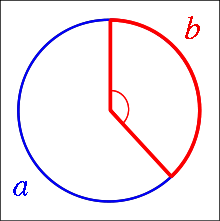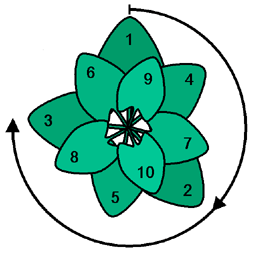Golden angle

In geometry, the golden angle is the smaller of the two angles created by sectioning the circumference of a circle according to the golden section; that is, into two arcs such that the ratio of the length of the larger arc to the length of the smaller arc is the same as the ratio of the full circumference to the length of the larger arc.
Algebraically, let a+b be the circumference of a circle, divided into a longer arc of length a and a smaller arc of length b such that
The golden angle is then the angle subtended by the smaller arc of length b. It measures approximately 137.508°, or about 2.39996 radians.
The name comes from the golden angle's connection to the golden ratio φ; the exact value of the golden angle is
or
where the equivalences follow from well-known algebraic properties of the golden ratio.
Derivation
The golden ratio is equal to φ = a/b given the conditions above.
Let ƒ be the fraction of the circumference subtended by the golden angle, or equivalently, the golden angle divided by the angular measurement of the circle.
But since
it follows that
This is equivalent to saying that φ 2 golden angles can fit in a circle.
The fraction of a circle occupied by the golden angle is therefore
The golden angle g can therefore be numerically approximated in degrees as:
or in radians as :
Golden angle in nature

The golden angle plays a significant role in the theory of phyllotaxis. Perhaps most notably, the golden angle is the angle separating the florets on a sunflower.
References
- Vogel, H (1979). "A better way to construct the sunflower head". Mathematical Biosciences 44 (44): 179–189. doi:10.1016/0025-5564(79)90080-4.
- Prusinkiewicz, Przemysław; Lindenmayer, Aristid (1990). The Algorithmic Beauty of Plants. Springer-Verlag. pp. 101–107. ISBN 978-0-387-97297-8.
External links
| Wikimedia Commons has media related to Golden angle. |








